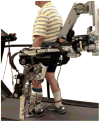Short-term Performance-based Error-augmentation versus Error-reduction Robotic Gait Training for Individuals with Chronic Stroke: A Pilot Study
- PMID: 27336075
- PMCID: PMC4914051
Short-term Performance-based Error-augmentation versus Error-reduction Robotic Gait Training for Individuals with Chronic Stroke: A Pilot Study
Abstract
The success of locomotion training with robotic exoskeletons requires identifying control algorithms that effectively retrain gait patterns in neurologically impaired individuals. Here we report how the two training paradigms, performance-based error-augmentation versus error-reduction, modified walking patterns in four chronic post-stroke individuals as a proof-of-concept for future locomotion training following stroke. Stroke subjects were instructed to match a prescribed walking pattern template derived from neurologically intact individuals. Target templates based on the spatial paths of lateral ankle malleolus positions during walking were created for each subject. Robotic forces were applied that either decreased (error-reduction) or increased (error-augmentation) the deviation between subjects' instantaneous malleolus positions and their target template. Subjects' performance was quantified by the amount of deviation between their actual and target malleolus paths. After the error-reduction training, S1 showed a malleolus path with reduced deviation from the target template by 16%. In contrast, S4 had a malleolus path further away from the template with increased deviation by 12%. After the error-augmentation training, S2 had a malleolus path greatly approximating the template with reduced deviation by 58% whereas S3 walked with higher steps than his baseline with increased deviation by 37%. These findings suggest that an error-reduction force field has minimal effects on modifying subject's gait patterns whereas an error-augmentation force field may promote a malleolus path either approximating or exceeding the target walking template. Future investigation will need to evaluate the long-term training effects on over-ground walking and functional capacity.
Keywords: Force field; Gait rehabilitation; Rehabilitation robotics; Stroke; Walking.
Figures







Similar articles
-
Effect of robotic performance-based error-augmentation versus error-reduction training on the gait of healthy individuals.Gait Posture. 2013 Jan;37(1):113-20. doi: 10.1016/j.gaitpost.2012.06.025. Epub 2012 Jul 24. Gait Posture. 2013. PMID: 22832470 Free PMC article. Clinical Trial.
-
A pilot study on the feasibility of robot-aided leg motor training to facilitate active participation.PLoS One. 2013 Oct 11;8(10):e77370. doi: 10.1371/journal.pone.0077370. eCollection 2013. PLoS One. 2013. PMID: 24146986 Free PMC article.
-
Exploration of Two Training Paradigms Using Forced Induced Weight Shifting With the Tethered Pelvic Assist Device to Reduce Asymmetry in Individuals After Stroke: Case Reports.Am J Phys Med Rehabil. 2017 Oct;96(10 Suppl 1):S135-S140. doi: 10.1097/PHM.0000000000000779. Am J Phys Med Rehabil. 2017. PMID: 28661914
-
The effects of error-augmentation versus error-reduction paradigms in robotic therapy to enhance upper extremity performance and recovery post-stroke: a systematic review.J Neuroeng Rehabil. 2018 Jul 4;15(1):65. doi: 10.1186/s12984-018-0408-5. J Neuroeng Rehabil. 2018. PMID: 29973250 Free PMC article.
-
A review of lower extremity assistive robotic exoskeletons in rehabilitation therapy.Crit Rev Biomed Eng. 2013;41(4-5):343-63. doi: 10.1615/critrevbiomedeng.2014010453. Crit Rev Biomed Eng. 2013. PMID: 24941413 Review.
Cited by
-
Application of an Auditory-Based Feedback Distortion to Modify Gait Symmetry in Healthy Individuals.Brain Sci. 2024 Aug 9;14(8):798. doi: 10.3390/brainsci14080798. Brain Sci. 2024. PMID: 39199490 Free PMC article.
-
Control strategies used in lower limb exoskeletons for gait rehabilitation after brain injury: a systematic review and analysis of clinical effectiveness.J Neuroeng Rehabil. 2023 Feb 19;20(1):23. doi: 10.1186/s12984-023-01144-5. J Neuroeng Rehabil. 2023. PMID: 36805777 Free PMC article.
-
Interlimb transfer of motor skill learning during walking: No evidence for asymmetric transfer.Gait Posture. 2017 Jul;56:24-30. doi: 10.1016/j.gaitpost.2017.04.032. Epub 2017 Apr 27. Gait Posture. 2017. PMID: 28482202 Free PMC article. Clinical Trial.
-
Improving Precision Force Control With Low-Frequency Error Amplification Feedback: Behavioral and Neurophysiological Mechanisms.Front Physiol. 2019 Feb 20;10:131. doi: 10.3389/fphys.2019.00131. eCollection 2019. Front Physiol. 2019. PMID: 30842742 Free PMC article.
References
-
- Bogey R, Hornby GT. Gait training strategies utilized in poststroke rehabilitation: are we really making a difference? Top Stroke Rehabil. 2007;14:1–8. - PubMed
-
- Backus D, Winchester P, Tefertiller C. Translating research into clinical practice: integrating robotics into neurorehabilitation for stroke survivors. Top Stroke Rehabil. 2010;17:362–370. - PubMed
-
- Vaney C, Gattlen B, Lugon-Moulin V, Meichtry A, Hausammann R, Foinant D, et al. Robotic-assisted step training (lokomat) not superior to equal intensity of over-ground rehabilitation in patients with multiple sclerosis. Neurorehabil Neural Repair. 2012;26:212–221. - PubMed
-
- Schwartz I, Sajin A, Moreh E, Fisher I, Neeb M, Forest A, et al. Robot-assisted gait training in multiple sclerosis patients: a randomized trial. Mult Scler. 2012;18:881–890. - PubMed
-
- Hornby TG, Campbell DD, Kahn JH, Demott T, Moore JL, Roth HR. Enhanced gait-related improvements after therapist- versus robotic-assisted locomotor training in subjects with chronic stroke: a randomized controlled study. Stroke. 2008;39:1786–1792. - PubMed
Grants and funding
LinkOut - more resources
Full Text Sources
